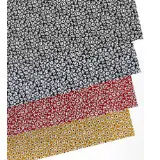

Item No. - RT-72 Description - rayon printing-width:145cm,105gsm,45; Material:100% viscose MOQ(Meter) - 1000 Price of product ( USD price ) - $1.15-1.38 Product origin - China Key Specifications/Special Features - "Rayon printing (stock) Place of Origin - China Payment Term - TT Delivery Time Shipment within 75 working days

Item No. - RT-73 Description - rayon printing-width:145cm,105gsm,45; Material:100% viscose MOQ(Meter) - 1000 Price of product ( USD price ) - $1.2-1.44 Product origin - China Key Specifications/Special Features - Rayon printing (stock) Place of Origin - China Payment Term - TT Delivery Time Shipment within 76 working days
Item No. - RT-74 Description - rayon printing-width:145cm,105gsm,45; Material:100% viscose MOQ(Meter) - 1000 Price of product ( USD price ) - $1.2-1.44 Product origin - China Key Specifications/Special Features - " Rayon printing (stock) Place of Origin - China Payment Term - TT Delivery Time Shipment within 77 working days
Item No. - RT-75 Description - rayon printing-width:145cm,105gsm,45; Material:100% viscose MOQ(Meter) - 1000 Price of product ( USD price ) - $1.15-1.38 Product origin - China Key Specifications/Special Features - Rayon printing (stock) Place of Origin - China Payment Term - TT Delivery Time Shipment within 78 working days
Item No. - RT-76 Description - rayon printing-width:145cm,105gsm,45; Material:100% viscose MOQ(Meter) - 1000 Price of product ( USD price ) - $1.15-1.38 Product origin - China Key Specifications/Special Features - Rayon printing (stock) Place of Origin - China Payment Term - T/T Delivery Time Shipment within 79 working days
Item No. - RT-77 Description - rayon printing-width:145cm,105gsm,45; Material:100% viscose MOQ(Meter) - 1000 Price of product ( USD price ) - $1.2-1.44 Product origin - China Key Specifications/Special Features - Rayon printing (stock Place of Origin - China Payment Term - TT Delivery Time Shipment within 80 working day
Item No. - RT-78 Description - rayon printing-width:145cm,105gsm,45; Material:100% viscose MOQ(Meter) - 1000 Price of product ( USD price ) - $1.2-1.44 Product origin - China Key Specifications/Special Features - Rayon printing (stock) Place of Origin - China Payment Term - TT Delivery Time Shipment within 81 working days
Item No. - RT-79 Description - rayon printing-width:145cm,105gsm,45; Material:100% viscose MOQ(Meter) - 1000 Price of product ( USD price ) - $1.2-1.44 Product origin - China Key Specifications/Special Features - Rayon printing (stock) Place of Origin - China Payment Term - TT Delivery Time Shipment within 82 working days
Item No. - RT-81 Description - rayon printing-width:145cm,105gsm,45; Material:100% viscose MOQ(Meter) - 1000 Price of product ( USD price ) - $1.15-1.38 Product origin - China Key Specifications/Special Features - Rayon printing (stock) Place of Origin - China Payment Term - TT Delivery Time Shipment within 84 working day
Item No. - RT-82 Description - rayon printing-width:145cm,105gsm,45; Material:100% viscose MOQ(Meter) - 1000 Price of product ( USD price ) - $1.15-1.38 Product origin - China Key Specifications/Special Features - Rayon printing (stock) Place of Origin - China Payment Term - TT Delivery Time Shipment within 85 working days
Item No. - RT-83 Description - rayon printing-width:145cm,105gsm,45; Material:100% viscose MOQ(Meter) - 1000 Price of product ( USD price ) - $1.15-1.38 Product origin - China Key Specifications/Special Features - Rayon printing (stock) Place of Origin - China Payment Term - TT Delivery Time Shipment within 86 working days
Item No. - RT-84 Description - rayon printing-width:145cm,105gsm,45; Material:100% viscose MOQ(Meter) - 1000 Price of product ( USD price ) - $1.15-1.38 Product origin - China Key Specifications/Special Features - Rayon printing (stock) Place of Origin - China Payment Term - TT Delivery Time Shipment within 87 working days
Item No. - RT-86 Description - rayon printing - width : 145cm,105gsm,45 Material : 100% viscose MOQ(Meter) - 1000 Price of product ( USD price ) - $1.15-1.38 Product origin - China Key Specifications/Special Features - Rayon printing (stock) Place of Origin - China Payment Term - TT Delivery Time Shipment within 89 working days
Item No. - RT-88 Description - rayon printing- width : 145cm,105gsm,45 Material : 100% viscose MOQ(Meter) - 1000 Price of product ( USD price ) - $1.15-1.38 Product origin - China Key Specifications/Special Features - Rayon printing (stock) Place of Origin - China Payment Term - TT Delivery Time Shipment within 91 working days
Item No. - RT-87 Description - rayon printing-width:145cm,105gsm,45 Material : 100% viscose MOQ(Meter) - 1000 Price of product ( USD price ) - $1.15-1.38 Product origin - China Key Specifications/Special Features - Rayon printing (stock) Place of Origin - China Payment Term - TT Delivery Time Shipment within 90 working days
Item No. - RT-89 Description - rayon printing-width:145cm,105gsm,45 Material : 100% viscose MOQ(Meter) - 1000 Price of product ( USD price ) - $1.15-1.38 Product origin - China Key Specifications/Special Features - Rayon printing (stock) Place of Origin - China Payment Term - TT Delivery Time Shipment within 92 working days
Item No. - RT-90 Description - rayon printing-width:145cm,105gsm,45 Material : 100% viscose MOQ(Meter) - 1000 Price of product ( USD price ) - $1.15-1.38 Product origin - China Key Specifications/Special Features - Rayon printing (stock) Place of Origin - China Payment Term - TT Delivery Time Shipment within 93 working days
Item No. - RT-91 Description - rayon printing width : 145cm,105gsm,45 Material : 100% viscose MOQ(Meter) - 1000 Price of product ( USD price ) - $1.15-1.38 Product origin - China Key Specifications/Special Features - Rayon printing (stock) Place of Origin - China Payment Term - TT Delivery Time Shipment within 94 working days
Item No. - RT-92 Description - rayon printing-width:145cm,105gsm,45 Material : 100% viscose MOQ(Meter) - 1000 Price of product ( USD price ) - $1.15-1.38 Product origin - China Key Specifications/Special Features - Rayon printing (stock) Place of Origin - China Payment Term - TT Delivery Time Shipment within 95 working days
















